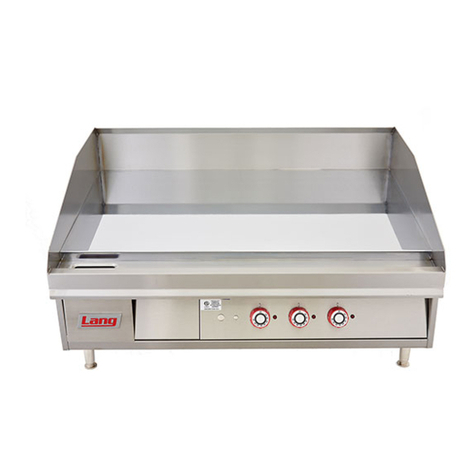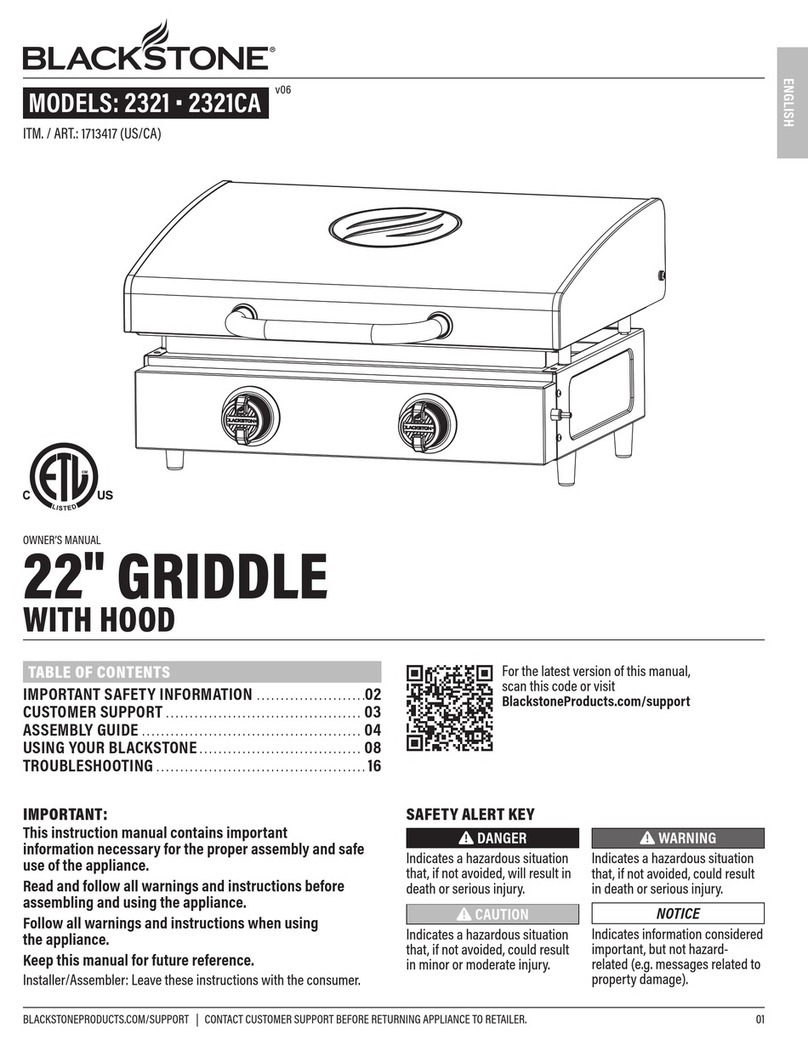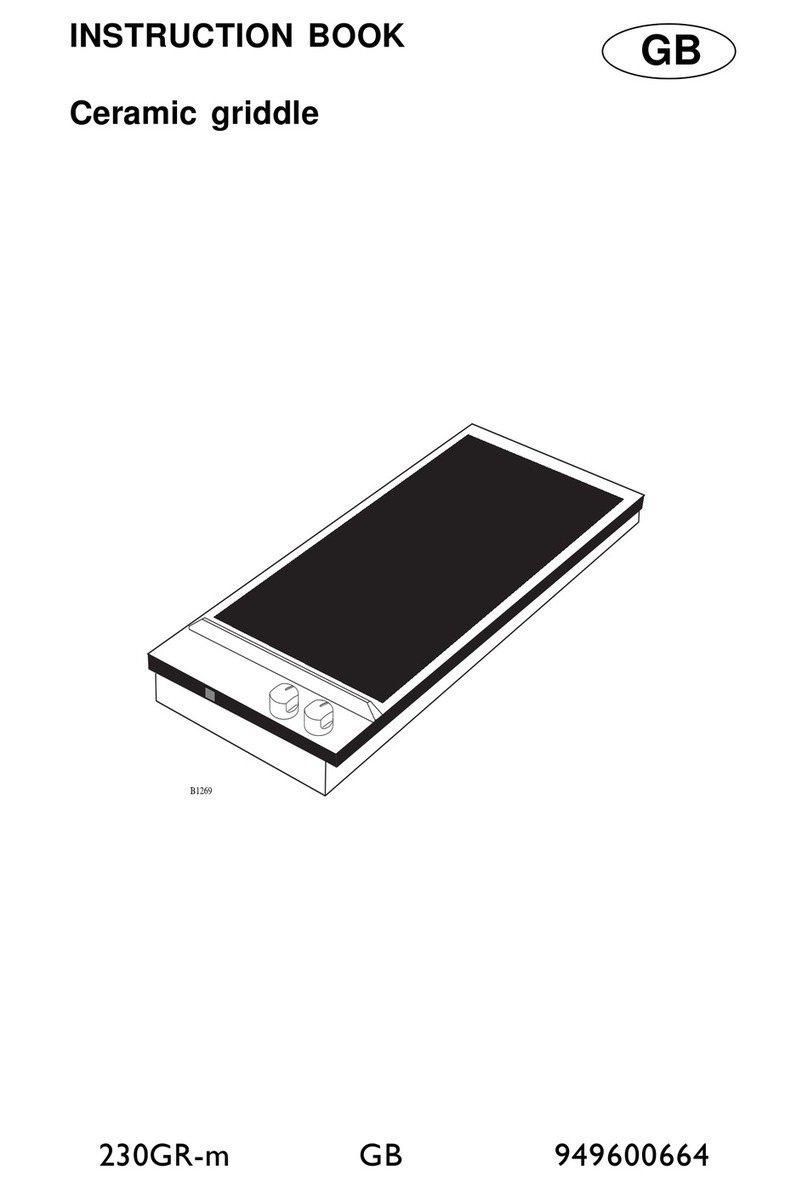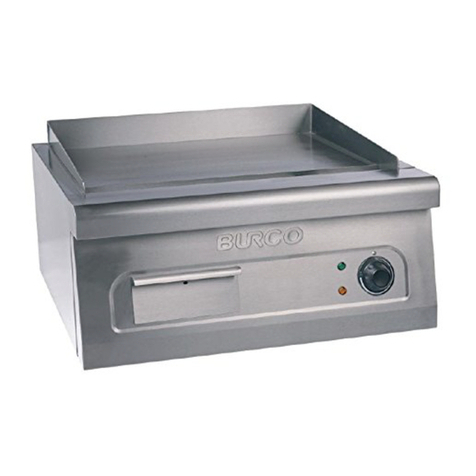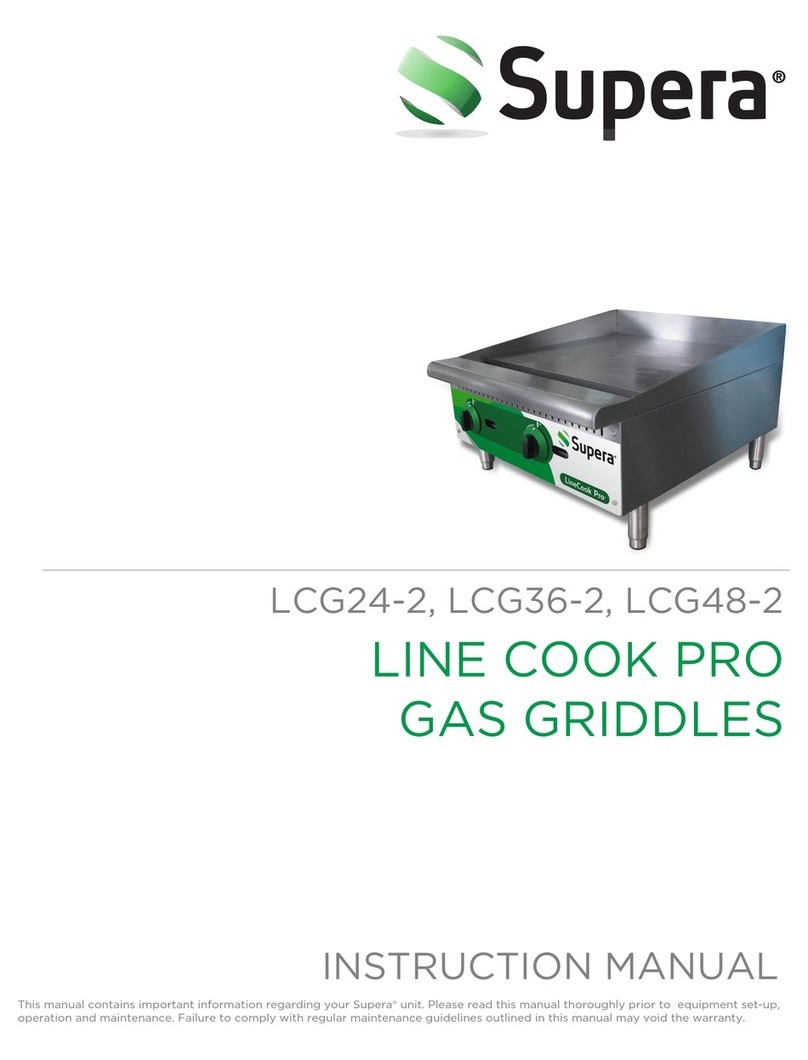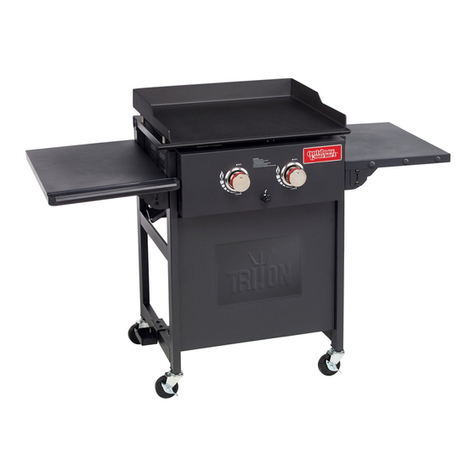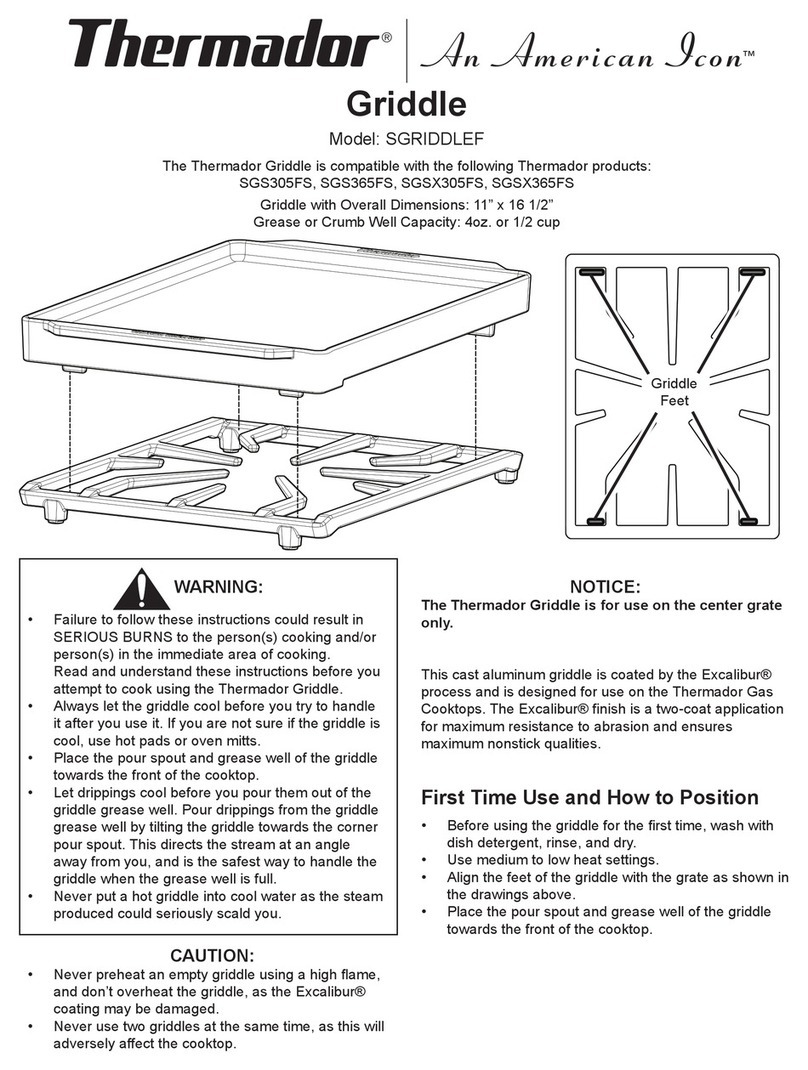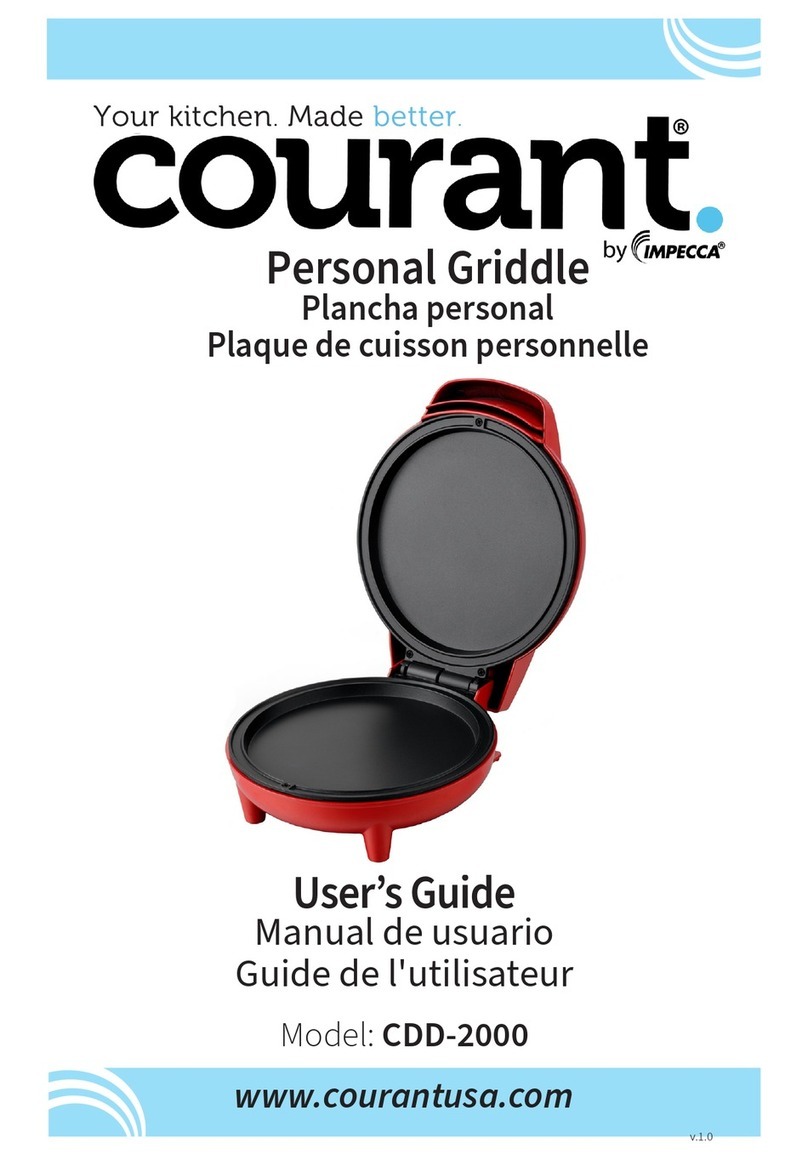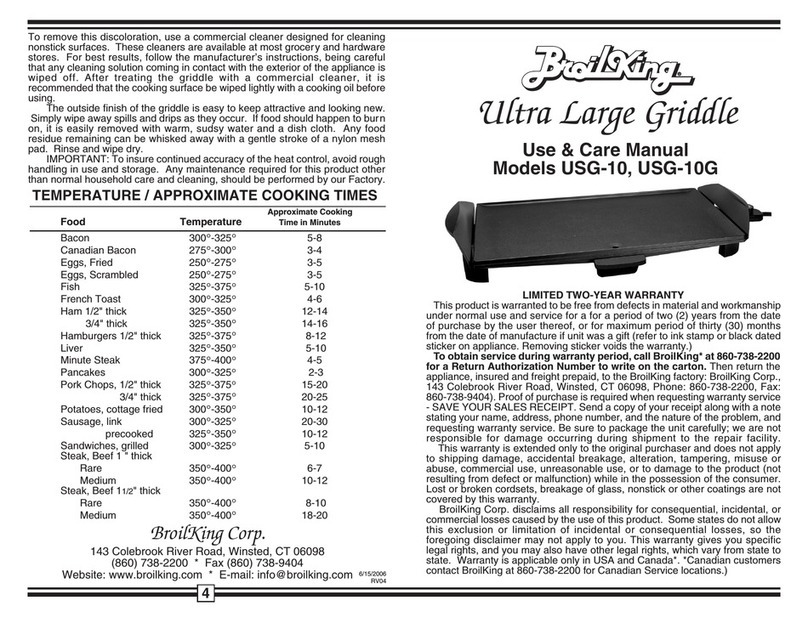INOX-bazis PLUS 600 Series User manual

cod. 31879000
OPERATING INSTRUCTIONS GAS GRIDDLE (Original instructions)
Warning: Read the instructions before putting the unit into operation. EN

|1
EN
Thistype ofapparatusis tobe used for commercialapplications,for example restaurant kitchens,
canteens, hospitals and commercial businesses, such as bakeries, butchers, etc., but not for
continual mass production of food.
The appliances require that some precautions are made during the installation, positioning and/
or xing. See the paragraph titled“INSTALLATION”.
The units need to be used and operated with some caution. See the paragraph“INSTRUCTIONS
FOR USE”.
The unit must not be cleaned with jets of water or steam cleaners.
Maintenance must be carried out by qualified personnel.
Do not aim water jets directly on the appliance, it might be damaged.

2
5
10
4
6
16 15 14
37
39
31
92 6228
30
X
PEL 25ST
PEL 21S
QUOTA REGOLAZIONE ARIA - REGULATION OF AIR SUPPLY - VALEUR RÉGLAGE
AIR LUFTEINSTELLUNGSWERT - COTA DE REGULACIÓN DEL AIRE - WAARDE LUCHTREGELING
COTA DE REGULAÇÃO DO AR -ΤΙΜΗ ΡΥΘΜΙΣΗΣ ΑΕΡΑ - HODNOTA REGULACE VZDUCHU
HODNOTA REGULÁCIE VZDUCHU - LEVEGŐ BEÁLLÍTÁS MÉRTÉKE - INDSTILLNG AF LUFT
NIVÅ FOR LUFTREGULERING - LUFTJUSTERINGSVÄRDE - WARTOŚCI REGULACJI POWIETRZA
COTĂ DE REGLARE AER - ОТМЕТКА РЕГУЛИРОВКИ ВОЗДУХА - HAVA AYAR PAYI -
3
3
3
4A
1 2

|3
4B
5A 5B
6
5
10
4
6
16 15 14
37
39
31
92 6228
30
X
PEL 25ST
PEL 21S
QUOTA REGOLAZIONE ARIA - REGULATION OF AIR SUPPLY - VALEUR RÉGLAGE
AIR LUFTEINSTELLUNGSWERT - COTA DE REGULACIÓN DEL AIRE - WAARDE LUCHTREGELING
COTA DE REGULAÇÃO DO AR - ΤΙΜΗ ΡΥΘΜΙΣΗΣ ΑΕΡΑ - HODNOTA REGULACE VZDUCHU
HODNOTA REGULÁCIE VZDUCHU - LEVEGŐ BEÁLLÍTÁS MÉRTÉKE - INDSTILLNG AF LUFT
NIVÅ FOR LUFTREGULERING - LUFTJUSTERINGSVÄRDE - WARTOŚCI REGULACJI POWIETRZA
COTĂ DE REGLARE AER - ОТМЕТКА РЕГУЛИРОВКИ ВОЗДУХА - HAVA AYAR PAYI -
3
3
5
10
4
6
16 15 14
37
39
31
92 6228
30
X
PEL 25ST
PEL 21S
QUOTA REGOLAZIONE ARIA - REGULATION OF AIR SUPPLY - VALEUR RÉGLAGE
AIR LUFTEINSTELLUNGSWERT - COTA DE REGULACIÓN DEL AIRE - WAARDE LUCHTREGELING
COTA DE REGULAÇÃO DO AR -ΤΙΜΗ ΡΥΘΜΙΣΗΣ ΑΕΡΑ - HODNOTA REGULACE VZDUCHU
HODNOTA REGULÁCIE VZDUCHU - LEVEGŐ BEÁLLÍTÁS MÉRTÉKE - INDSTILLNG AF LUFT
NIVÅ FOR LUFTREGULERING - LUFTJUSTERINGSVÄRDE -WARTOŚCI REGULACJI POWIETRZA
COTĂ DE REGLARE AER - ОТМЕТКА РЕГУЛИРОВКИ ВОЗДУХА - HAVA AYAR PAYI -
3
3

|4
EN
BURNERS
G6F..3B
G6F..3M
G6F..3B/CR
G6F..3M/CR
G6F..6B
G6F..6M
G6F..6B/CR
G6F..6M/CR
G7F..4B/CPD
G7F..4M/CPD
G7F..8B-2/CPD
G7F..8M-2/CPD
SG7F..4B/CPD -
SG7F..8B-2/CPD -
G7F..4B - G7F..4M -
G7F..8B-2 - G7F..8M-2
LXG9F../CPD -
SG9F../CPD - G9F..4M -
G9F..8M-2 - G9F../CPD
Rated output per burner kW 4 8 6,9 6,9 10
Reduced power per burner kW 1,8 4 2,5 2,5 4
Gas name Griddle Ø Main nozzles
Ø By Pass
Primary air reg. Ø Pilot nozzles
GAS G20 20 mbar G6F..3B G6F..3M G6F..3B/CR G6F..3M/CR
150
Adjustable
14 mm 41
METHANE
G6F..6B G6F..6M G6F..6B/CR G6F..6M/CR
210
Adjustable
11 mm 41
G7F... G7F../CPD SG7F../CPD
180R
Adjustable
23 mm 27_2
II2H3+ G9F... G9F../CPD LXG9F../CPD SG9F../CPD
230R
Adjustable
21 mm 27_2
SUPPLY PRESSURE:
(min÷max)
G20 17÷25 mbar
GAS G30/G31
G6F..3B G6F..3M G6F..3B/CR G6F..3M/CR
95 70 18 mm 25
28-30/37mbar
G6F..6B G6F..6M G6F..6B/CR G6F..6M/CR
145 100 22 mm 25
LPG
G7F... G7F../CPD SG7F../CPD
130 75 20 mm 22
II2H3+ G9F... G9F../CPD LXG9F../CPD SG9F../CPD
160 105 31 mm 22
SUPPLY PRESSURE:
(min÷max)
G30 25÷45 mbar
G31 25÷45 mbar

5|
MOD.
VkW: Hz: 50/60 IP
Qn
N°:
MOD.
VkW: Hz: 50/60 IPX2
Qn
N°:
290
410
45 R1/2
600
20 R1/2
15 R1/2
300
290
410
45 R1/2
600
20 R1/2
15 R1/2
300
45 R1/2
290
410
20 R1/2
15 R1/2
600
600
45 R1/2
290
410
20 R1/2
15 R1/2
600
600
45 R1/2
290
410
20 R1/2
15 R1/2
600
600
600
300
600
300
900
1020
140
120
100 R1/2
270 R1/2
13.5 R1/2
270 R1/2
13.5 R1/2
900
1020
140
120
100 R1/2
G6FL3M G6FR3M G6FL3M/CR
G6FL6B G6FR6B G6FM6B G6FL6B/CR
G6FL6M - G6FR6M G6FM6M G6FL6M/FR
G6FL3B G6FR3B G6FL3B/CR
600
600
900
1020
140
120
100 R1/2
270 R1/2
13.5 R1/2
600
600
900
1020
140
120
100 R1/2
270 R1/2
13.5 R1/2
600
600
900
1020
140
120
100 R1/2
270 R1/2
13.5 R1/2

|6
MOD.
VkW: Hz: 50/60 IP
Qn
N°:
MOD.
VkW: Hz: 50/60 IPX2
Qn
N°:
G7FL4B- G7FR4B - G7FL4B/CPD
G7FL4M - G7FR4M - G7FL4M/CPD
G7FL8B-2 - G7FR8B-2 - G7FM8B-2 - G7FL8B-2/CPD
G7FL8M-2 - G7FR8B-2 - G7FM8B-2 - G7FL8M-2/CPD
290
456
166
41 318 41
45
714
400
75
73
290
456
166
41 318 41
45
714
400
75
73
290
456
166
41 318 41
45
714
400
75
73
900
1070
140
288 5656
100 (1/2"G)
714
400
215 (1/2"G)
13 (1/2"G)
900
1070
140
288 5656
100 (1/2"G)
714
400
215 (1/2"G)
13 (1/2"G)
900
1070
140
288 5656
100 (1/2"G)
714
400
215 (1/2"G)
13 (1/2"G)
900
1070
140
688 5656
100 (1/2"G)
714
800
212 (1/2"G)
13 (1/2"G)
900
1070
140
688 5656
100 (1/2"G)
714
800
212 (1/2"G)
13 (1/2"G)
900
1070
140
688 5656
100 (1/2"G)
714
800
212 (1/2"G)
13 (1/2"G)
900
1070
140
688 5656
100 (1/2"G)
714
800
212 (1/2"G)
13 (1/2"G)
41 718 41
290 167
457
47 (1/2"G)
714
800
42 (1/2"G)
14 (1/2"G)
41 718 41
290 167
457
47 (1/2"G)
714
800
42 (1/2"G)
14 (1/2"G)
41 718 41
290 167
457
47 (1/2"G)
714
800
42 (1/2"G)
14 (1/2"G)
41 718 41
290 167
457
47 (1/2"G)
714
800
42 (1/2"G)
14 (1/2"G)

7|
MOD.
VkW: Hz: 50/60 IP
Qn
N°:
MOD.
VkW: Hz: 50/60 IPX2
Qn
N°:
SG7FL4B/CPD - SG7FR4B/CPD
G9FL8M-2 - G9FR8M-2 - G9FM8M-2 - G9FL8M-2/CPD
SG7FR4B/CPD - SG7FR8B-2/CPD - SG7FM8B-2/CPD
G9FL4M - G9FR4M - G9FL4M/CPD
270
460
50 R1/2
730
400
60 R1/2
40 R1/2
270
460
50 R1/2
730
400
60 R1/2
40 R1/2
270
460
50 R1/2
730
800
60 R1/2
40 R1/2
270
460
50 R1/2
730
800
60 R1/2
40 R1/2
270
460
50 R1/2
730
800
60 R1/2
40 R1/2
270
460
50 R1/2
730
400
60 R1/2
40 R1/2
270
460
50 R1/2
730
400
60 R1/2
40 R1/2
270
460
50 R1/2
730
800
60 R1/2
40 R1/2
270
460
50 R1/2
730
800
60 R1/2
40 R1/2
270
460
50 R1/2
730
800
60 R1/2
40 R1/2

|8
MOD.
VkW: Hz: 50/60 IP
Qn
N°:
MOD.
VkW: Hz: 50/60 IPX2
Qn
N°:
SG9FL4M/CPD - SG9FR4M/CPD
LXG9FL4/CPD - LXG9FR4/CPD
SG9FL8M-2/CPD - SG9FR8M/CPD - SG9FM8M/CPD
LXG9FL8-2/CPD - LXG9FR8-2/CPD - LXG9FM8-2/CPD
290
450
45 R1/2
900
30 R1/2
75 R1/2
400
290
450
900
45 R1/2
30 R1/2
75 R1/2
800

9|
EN
MOD.
VkW: Hz: 50/60 IPX2
Qn
N°:
Instruction manual
Dimensions 10
Technical data 12
Specic instructions 14

|10
EN
MOD.
VkW: Hz: 50/60 IPX2
Qn
N°:
Unit type Description Dim.: (LxPxW) Worktop (total h) Type
G6FL3B Smooth griddle mm 300 x 600 x 290 (410) A1
G6FL3B/CR Smooth chromium-plated griddle mm 300 x 600 x 290 (410) A1
G6FR3B Ribbed griddle mm 300 x 600 x 290 (410) A1
G6FL3M Smooth griddle with cabinet mm 300 x 600 x 900 (1020) A1
G6FL3M/CR Smooth chromium-plate griddle with cabinet mm 300 x 600 x 900 (1020) A1
G6FR3M Ribbed griddle with cabinet mm 300 x 600 x 900 (1020) A1
G6FL6B Smooth griddle mm 600 x 600 x 290 (410) A1
G6FL6B/CR Smooth chromium-plated griddles mm 600 x 600 x 290 (410) A1
G6FR6B Ribbed griddles mm 600 x 600 x 290 (410) A1
G6FM6B Mixed smooth/ribbed griddles mm 600 x 600 x 290 (410) A1
G6FL6M Smooth griddle with cabinet mm 600 x 600 x 900 (1020) A1
G6FL6M/CR Smooth chromium-plated griddle with cabinet mm 600 x 600 x 900 (1020) A1
G6FR6M Ribbed griddle with cabinet mm 600 x 600 x 900 (1020) A1
G6FM6M Mixed smooth/ribbed griddle with cabinet mm 600 x 600 x 900 (1020) A1
Unit type Description Dim.: (LxPxW) Worktop (total h) Type
G7FL4B Smooth griddle mm 400 x 700 x 290 (430) A1
G7FL4B/CPD Smooth compound griddle mm 400 x 700 x 290 (430) A1
G7FR4B Ribbed griddle mm 400 x 700 x 290 (430) A1
G7FL4M Smooth griddle with cabinet mm 400 x 700 x 900 (1040) A1
G7FL4M/CPD Smooth compound griddle with cabinet mm 400 x 700 x 900 (1040) A1
G7FR4M Ribbed griddle with cabinet mm 400 x 700 x 900 (1040) A1
G7FL8B-2 2-area smooth griddle mm 800 x 700 x 290 (430) A1
G7FL8B-2/CPD 2-area smooth compound griddle mm 800 x 700 x 290 (430) A1
G7FR8B-2 2-area ribbed griddle mm 800 x 700 x 290 (430) A1
G7FM8B-2 2-area mixed smooth/ribbed griddle mm 800 x 700 x 290 (430) A1
G7FL8M-2 2-area smooth griddle with cabinet mm 800 x 700 x 900 (1040) A1
G7FL8M-2/CPD 2-area smooth compound griddle with cabinet mm 800 x 700 x 900 (1040) A1
G7FR8M-2 2-area ribbed griddle with cabinet mm 800 x 700 x 900 (1040) A1
G7FM8M-2 2-area mixed/ribbed griddle with cabinet mm 800 x 700 x 900 (1040) A1
Unit type Description Dim.: (LxPxW) Worktop (total h) Type
G9FL4M Smooth griddle with cabinet mm 400 x 900 x 900 (1065) A1
G9FL4M/CPD Smooth chromium-plated griddle with cabinet mm 400 x 900 x 900 (1065) A1
G9FR4M Ribbed griddle with cabinet mm 400 x 900 x 900 (1065) A1
G9FL8M-2 2-area smooth griddle with cabinet mm 800 x 900 x 900 (1065) A1
G9FL8M-2/CPD 2-area compound smooth griddle with cabinet mm 800 x 900 x 900 (1065) A1
G9FR8M-2 2-area ribbed griddle with cabinet mm 800 x 900 x 900 (1065) A1
G9FM8M-2 2-area 2/3 smooth and 1/3 ribbed compound griddle mm 800 x 900 x 900 (1065) A1
GAS GRIDDLE - SERIE PLUS 600
GAS GRIDDLE - SERIE MACROS 700
GAS GRIDDLE - SERIE MAXIMA 900

11 |
EN
MOD.
VkW: Hz: 50/60 IPX2
Qn
N°:
Unit type Description Dim.: (LxPxW) Worktop (total h) Type
SG7FL4B/CPD Smooth compound griddle mm 400 x 730 x 250 (455) A1
SG7FR4B/CPD Ribbed compound griddle mm 400 x 730 x 250 (455) A1
SG7FL8B-2/CPD 2-area smooth compound griddle mm 800 x 730 x 250 (455) A1
SG7FM8B-2/CPD 2-area 2/3 smooth and 1/3 ribbed compound griddle mm 800 x 730 x 250 (455) A1
SG7FR8B-2/CPD 2-area ribbed compound griddle mm 800 x 730 x 250 (455) A1
GAS GRIDDLE - SERIE S700
Unit type Description Dim.: (LxPxW) Worktop (total h) Type
SG9FL4M/CPD Smooth compound griddle with cabinet mm 400 x 900 x 900 (1065) A1
SG9FR4M/CPD Ribbed compound griddle with cabinet mm 400 x 900 x 900 (1065) A1
SG9FL8M-2/CPD 2-area smooth compound griddle with cabinet mm 800 x 900 x 900 (1065) A1
SG9FR8M-2/CPD 2-area ribbed compound griddle with cabinet mm 800 x 900 x 900 (1065) A1
SG9FM8M-2/CPD 2-area smooth compound griddle mm 800 x 900 x 900 (1065) A1
Unit type Description Dim.: (LxPxW) Worktop (total h) Type
LXG9FL4/CPD Smooth compound griddle mm 400 x 900 x 290 (430) A1
LXG9FR4/CPD Ribbed compound griddle mm 400 x 900 x 290 (430) A1
LXG9FL8-2/CPD 2-area smooth compound griddle mm 800 x 900 x 290 (430) A1
LXG9FM8-2/CPD 2-area 2/3 smooth and 1/3 ribbed compound griddle mm 800 x 900 x 290 (430) A1
LXG9FR8-2/CPD 2-area ribbed compound griddle mm 800 x 900 x 290 (430) A1
GAS GRIDDLE - SERIE S900
GAS GRIDDLE - SERIE LX900 TOP

|12
EN
MOD.
VkW: Hz: 50/60 IPX2
Qn
N°:
MODEL
Rated
output
Rated
output
G110
Rated
output
G120
G30/31 LPG
consumption
G20 Methane
consump-
tion
G25 - G25.1
Methane
consumption
G27
Methane
consumption
G110
town gas
consumption
G120
town gas
consumption
G2.350
Methane
consumption
G150.1 town
gas consump-
tion
Primary air
for combus-
tion
Construction
type
600 series sin-
gle Griddle
600 series
double Griddle
700 series
single Griddle
900
series single
Griddle
Tap
/
Valve
kW kW kW kg/h m3/h m3/h m3/h m3/h m3/h m3/h m3/h m3/h n° kW n° kW n° kW n° kW
G6FL3B - G6FR3B - G6FL3M -
G6FR3M 4 4 4 0,31 0,42 0,49 0,52 1,032 0,92 0,59 0,74 8 A1 1 4 21 S
G6FL6B - G6FR6B - G6FM6B -
G6FL6M - G6FR3M - G6FM6M 8 8 8 0,63 0,85 0,98 1,04 2,065 1,837 1,18 1,49 16 A1 1 8 21 S
G6FL3B/CR - G6FL3M/CR 4 4 4 0,31 0,42 0,49 0,52 1,032 0,92 0,59 0,74 8 A1 1 4 25 ST
G6FL6B/CR - G6FL6M/CR 8 8 8 0,63 0,85 0,98 1,04 2,065 1,837 1,18 1,49 16 A1 1 8 25 ST
MODEL
Rated
output
Rated
output
G110
Rated
output
G120
G30/31 LPG
consumption
G20 Methane
consump-
tion
G25 - G25.1
Methane
consumption
G27
Methane
consumption
G110
town gas
consumption
G120
town gas
consumption
G2.350
Methane
consumption
G150.1
town gas
consumption
Primary air
for combus-
tion
Construction
type
600 series sin-
gle Griddle
600 series
double Griddle
700 series
single Griddle
900
series single
Griddle
Tap
/
Valve
kW kW kW kg/h m3/h m3/h m3/h m3/h m3/h m3/h m3/h m3/h n° kW n° kW n° kW n° kW
G7FL4B - G7FR4B - G7FL4M -
G7FR4M 6,9 6,9 6,9 0,54 0,73 0,85 0,89 1,78 1,58 1,01 1,28 13,8 A1 1 6,9 21 S
G7FL8B-2 - G7FR8B-2 - G7FM8B-2 -
G7FR8M-2 - G7FM8M-2 - G7FL8M-2
13,8 13,8 13,8 1,08 1,46 1,70 1,78 3,56 3,16 2,02 2,56 27,6 A1 2 6,9 21 S
G7FL4B/CPD - G7FL4M/CPD 6,9 6,9 6,9 0,54 0,73 0,85 0,89 1,78 1,58 1,01 1,28 13,8 A1 1 6,9 25 ST
G7FL8B-2/CPD - G7FL8M-2/CPD 13,8 13,8 13,8 1,08 1,46 1,70 1,78 3,56 3,16 2,02 2,56 27,6 A1 2 6,9 25 ST
MODEL
Rated
output
Rated
output
G110
Rated
output
G120
G30/31 LPG
consumption
G20 Methane
consump-
tion
G25 - G25.1
Methane
consumption
G27
Methane
consumption
G110
town gas
consumption
G120
town gas
consumption
G2.350
Methane
consumption
G150.1
town gas
consumption
Primary air
for combus-
tion
Construction
type
600 series sin-
gle Griddle
600 series
double Griddle
700 series
single Griddle
900
series single
Griddle
Tap
/
Valve
kW kW kW kg/h m3/h m3/h m3/h m3/h m3/h m3/h m3/h m3/h n° kW n° kW n° kW n° kW
G9FL4M - G9FR4M - G9FL4M/CPD 10 7,5 8 0,8 1,06 1,23 1,3 1,94 1,84 1,47 1,4 20 A1 1 10
21S
G9FL8M-2 - G9FR8M-2 -
G9FM8M-2 - G9FL8M-2/CPD 20 15 16 1,6 2,12 2,46 2,6 3,88 3,68 2,94 2,8 40 A1 2 10
21S
G9FL4M/CPD 10 7,5 8 0,8 1,06 1,23 1,3 1,94 1,84 1,47 1,4 20 A1 1 10 25ST
G9FL8M-2/CPD 20 15 16 1,6 2,12 2,46 2,6 3,88 3,68 2,94 2,8 40 A1 2 10 25ST
TECHNICAL DATA
TECHNICAL DATA
TECHNICAL DATA
GAS GRIDDLE - PLUS 600
GAS GRIDDLE - MACROS 700
GAS GRIDDLE - MAXIMA 900

13 |
EN
MOD.
VkW: Hz: 50/60 IPX2
Qn
N°:
MODEL
Rated
output
Rated
output
G110
Rated
output
G120
G30/31 LPG
consumption
G20 Methane
consump-
tion
G25 - G25.1
Methane
consumption
G27
Methane
consumption
G110
town gas
consumption
G120
town gas
consumption
G2.350
Methane
consumption
G150.1
town gas
consumption
Primary air
for com-
bustion
Construction
type
600 series sin-
gle Griddle
600 series
double Griddle
700 series
single Griddle
900
series single
Griddle
Tap
/
Valve
kW kW kW kg/h m3/h m3/h m3/h m3/h m3/h m3/h m3/h m3/h n° kW n° kW n° kW n° kW
SG9FL4M/CPD - SG9FR4M/CPD -
LXG9FL4/CPD - LXG9FR4/CPD 10 7,5 8 0,8 1,06 1,23 1,3 1,94 1,84 1,47 1,4 20 A1 1 10 25 ST
SG9FL8M-2/CPD - SG9FR8M-2/CPD -
SG9FM8M-2/CPD - LXG9FL8-2/CPD
- LXG9FR8-2/CPD - LXG9FM8-2/CPD
20 15 16 1,6 2,12 2,46 2,6 3,88 3,68 2,94 2,8 40 A1 2 10 25 ST
MODEL
Rated
output
Rated
output
G110
Rated
output
G120
G30/31 LPG
consumption
G20 Methane
consump-
tion
G25 - G25.1
Methane
consumption
G27
Methane
consumption
G110
town gas
consumption
G120
town gas
consumption
G2.350
Methane
consumption
G150.1
town gas
consumption
Primary air
for com-
bustion
Construction
type
600 series sin-
gle Griddle
600 series
double Griddle
700 series
single Griddle
900
series single
Griddle
Tap
/
Valve
kW kW kW kg/h m3/h m3/h m3/h m3/h m3/h m3/h m3/h m3/h n° kW n° kW n° kW n° kW
SG7FL4B/CPD - SG7FR4B/CPD 6,9 6,9 6,9 0,54 0,73 0,85 0,89 1,78 1,58 1,01 1,28 13,8 A1 1 6,9 25ST
SG7FL8B-2/CPD - SG7FR8B-2/CPD -
SG7FM8B-2/CPD
13,8 13,8 13,8 1,08 1,46 1,70 1,78 3,56 3,16 2,02 2,56 27,6 A1 2 6,9 25ST
TECHNICAL DATA
TECHNICAL DATA
GAS GRIDDLE - S900 / LX900 TOP
GAS GRIDDLE - S700

|14
EN
MOD.
VkW: Hz: 50/60 IPX2
Qn
N°:
ATTENTION!
The figures mentioned in the chapters are shown on the initial pages of this manual.
SPECIFIC INSTRUCTIONS
APPLIANCE DESCRIPTION
Sturdy stainless steel structure with 4 feet that can be
adjusted in height. External coat made of AISI 304 or AISI
430 steel. The special steel plate has a smooth or ribbed
surface, equipped with side and back steel splashguards
or an oil collecting groove along the perimeter of the
unit. The plate is heated by tubular steel burners resistant
to thermal or mechanical stresses. The pilot burner is
equipped with a safety device and a thermocouple. The
temperature can be regulated by means of proper taps
equipped with safety devices.
The double module modes are equipped with separate
cooking areas and independent temperature controls.
PREPARATION
Location
The appliance should be installed in a well ventilated room
and, if possible, under a range hood. The appliance can be
installed on its own or alongside other equipment. Always
keep a minimum distance of 150 mm on the sides and 150
mm on the back from the wall.
The walls near the appliance (walls, decorations, kitchen
cabinets, decorative finishes, etc.) must be made of non-
flammable material.
If the unit is to be positioned on a table or a shelf, make sure
their materials are non-flammable. Before connecting the
appliance to the gas supply, check the data plate to make
sure that the appliance is fitted for the type of available
gas. If not, see the paragraph “Running appliances on
other types of gas".
Law provisions, technical regulations and directives
Before installing, check that the following provisions are
met:
- UNI CIG 8723 regulation
- building regulations and local fire prevention measures;
- accident prevention regulations in force;
- local Gas Board regulations;
- IEC provisions in force;
- Fire Brigade provisions.
ASSEMBLY
Assembly, installation and maintenance must all be
done by contractors authorized by the local Gas Board
in accordance with the regulations in force. Before doing
anything else, contact your Gas Board.
Installation procedure
To level the appliance correctly, adjust the height of the
four adjustable feet.
Gas connection
The 3/4” G or 1/2” G gas pipe union can either be
permanently fixed or detached by using a standard
adaptor. If a flexible hose is used, it must be stainless steel
and in conformity with regulations. After completing
the connection, check for leaks by using a special leak-
detector spray.
Exhaust system
The appliances must be positioned in locations adapted
with a system for discharging the products of combustion
in respect of how much is prescribed by the norms of the
installation; such a system must comply with installation
regulations. Our appliances are classified as type “A1”
gas units (see the "TECHNICAL DATA” table). They are not
designed for the connection to a line for the discharge of
products of combustion.
These appliances must discharge the products of
combustion into appropriate hoods, or similar devices,
connected to a flue of proven efficiency, or they may be
connected directly to an outdoor vent.
If such an arrangement is not possible, the unit may be
connected to an air exhaust system which leads directly
outdoors, having a capacity no lower than required;
see the “TECHNICAL DATA” table, plus the air exchange
necessary, in order to make operators comfortable.
INSTALLATION
Before installation
Before installing the appliance, remove the protective
wrapping. Thoroughly clean the work-surface and the
outside of the appliance with lukewarm water and
detergent, using a soft cloth. Dry with a clean cloth.
Start-up
Before starting the appliance, make sure that its
specifications (category and type of gas used) match those
of the family and group of the gas available locally.
If not, adapt the appliance to the gas family or group
required (see paragraph “Running the appliance on other
types of gas”). Carry out the start-up according to the
User’s Instructions.
Testing power rating
Use the nozzles for rated output on the appliances.
Capacity can be of two types:
- rated output, as given on the data plate;

15 |
EN
MOD.
VkW: Hz: 50/60 IPX2
Qn
N°:
- reduced.
These nozzles are shown in the table“BURNERS”.
The gas supply pressure must always be within the ranges
shown in the burners table.
The appliance will not work outside the above pressure
thresholds.
If you wish to check the rated output further, you may
do so by using a gas meter according to the so-called
”volumetric method”.
However, it is normally enough to simply check that the
nozzles are functioning correctly.
Checking input pressure (Fig. 1-2-3)
The input pressure should be measured by using a gauge
(min. resolution 0.1 mbar).
Remove the screw (22) from the pressure socket and
connect the gauge; after measuring, retighten the screw
so that it’s absolutely airtight (22).
IMPORTANT: The pressure must be checked with all gas
equipment connected and operating.
Check the power according to the volumetric method
Using a gas counter and a stopwatch, you can measure the
gas consumption in a given unit of time. This value will be
compared with the value E, which is calculated as follows:
E= Burner power
Gas heating power
It’s important that the power is measured when the
appliance is in a state of inertia.
Both rated and reduced powers, calculated at the rated
pressure value, are obtained by referring to the "BURNERS"
table. The value of gas heating power can be requested
from the local gas company.
Checking the operation
Ensure that the type of used nozzles corresponds to
that shown in the “BURNERS” table. Check whether the
pressure reducer has a flow rate greater than the sum of
the consumption flow rate of all connected equipment.
Check that the gas supply pipes are adequate.
Checking the pilot light
When correctly adjusted, the pilot light will completely
surround the thermocouple; if it does not, check to see if
the used injector is suitable for the type of gas.
Checking primary air (Fig. 4A)
Regulation is performed by a Venturi pipe by adjusting
the “A”height shown in the“BURNERS” table and verifying
the aspect of the flame is uniform, well ventilated and not
noisy.
Checking the functions
- Start the appliance;
- Check the gas pipes for leaks;
- Check the burner flame, even at the minimum.
Notes for the installer
- Explain and demonstrate how the appliance works to
the user according to the instructions, and hand him
the user’s manual.
- Remind the user that, in the event of any structural
alterations or modifications to the room that houses the
appliance, the appliance functions must be rechecked.
Running the appliance on other types of gas
To change over to another type of gas, for example from
methane to liquid, use the correct type of nozzles for the
burner in accordance to the“BURNERS”table.
The nozzles of the burners for different types of gas,
marked in 100ths of mm, are in a case supplied with the
appliance. When the appliance has been transformed
or adapted, recheck its functions as described in
paragraph "Checking the functions". Once you change the
predisposition, indicate the new type of gas on the label.
Replacing the nozzle of the main burner (Fig. 4A - 4B)
To replace the nozzle (30), remove the gravy collection
tray and unloose the fixing screws of the control panel.
Remove the control panel. Use a proper wrench to loosen
the nozzle from its nozzle holder and replace the nozzle
with a new one (see the “BURNERS” table). If necessary,
push the air adjustment coupling back by loosening the
screw (39); that way, the replacement will be easier. After
positioning the new nozzle, restore the distance of the "A"
primary air (see the "BURNERS" table).
Regulation of the pilot light (Fig. 5A - 5B)
The pilot light operates with a nozzle and fixed air.The only
requested operation is to replace the nozzles according to
the gas type as follows:
- Remove the control panel by loosening the fixing
screws.
- Loosen the nut pressing the biconical coupling (no. 14);
remove it (no. 15) and the pilot nozzle (no. 16).
- Replace the pilot nozzle with the correct nozzle,
consulting the“BURNERS”table.
- After replacing the pilot nozzle, retighten the nut
pressing the biconical coupling (no. 14) with the
relevant biconical coupling (no. 15).
Idle adjustment of the PEL 25ST for thermostat models
(Fig. 1)
After having removed the contro panel, adjust the low
flame screw (20) as follows:
- when using LPG, it should be fully screwed down;
- if natural gas is used:
1- Find the knob of the corresponding cock.
2- Turn on the burner, set the maximum temperature
and once it reaches it, turn it to the minimum.
3- Adjust the minimun flow by means of the screw
(20). The flow increases by loosening the screw and
decreases by tightening it.
4- Once the flame is considered suitable for a minimum
setting, check that it corresponds to the minimum
capacity indicated in the table on burners.
5- If the power is less than the value in the table, turn
the minimum screw again and repeat the check
6- If the power is greater than the value indicated in the
table, tighten the minimun flow screw and repeat
the check.

|16
EN
MOD.
VkW: Hz: 50/60 IPX2
Qn
N°:
Idle adjustment of the PEL 21 for thermostat models
(Fig. 2)
Consult the “BURNERS” table and adjust the low flame
screw (20) as follows:
- when using liquid gas, tighten the minimum
adjustment screw all the way down
- when using methane:
1 Locate the knob of the corresponding tap.
2 Turn the burner on and put it at the minimum output
position.
3 Adjust the minimum flow rate with screw 20 (Fig.
1-2). Unscrew to increase the flow rate and tighten
to decrease it.
4 Once the flame is judged as suitable for a minimum
setting, check that it corresponds to the minimum
flow indicated in the “TECHNICAL DATA” table.
The check must be carried out according to the
“volumetric method”, described above, as follows
5 Read the gas counter and, at the same time, start the
stopwatch.
6 After quite long time, for example 10 minutes, stop
the stopwatch and read the gas counter again.
7
Calculate how much gas has passed in 10 minutes
(the difference between the two readings), for
example 1st reading - 2nd reading = 30 liters (0,03m³).
8 Now calculate the minimum power by applying the
volumetric method formula (previous paragraph).
Power (kw) = consumption (m³/h) for heating power
of methane
9 If the power is less than the table value, loosen the
low flame screw again and check again.
10
If the power is higher than the table value, tighten the
low flame screw again and check again. (9.45 kw/h). P
(kw) = 30 liters x 60/10 x 9.45 kw/h = 1.700 kw
MAINTENANCE
Attention!
Before affecting any maintenance or repair operation,
disconnect the appliance from the gas power supply.
The following maintenance program should be carried out
at least once a year:
- check that all the safety and setting devices are working
properly;
- check that the burners are working properly with
regard to:
• ignition;
• combustion safety;
- check the various functions of the appliance by
following the procedure described in the "Checking the
functions" paragraph;
- check that the gas exhaustion way is integral.
Whenever the main burner needs cleaning, proceed as
follows (Fig. 4A - 4B):
a) remove the control knobs, the gravy collection tray and
the control panel after having unscrewed the fixing
screws;
b) remove the gas pipe from the nozzle holder by
unscrewing the proper nipple (28);
c) remove the fixing screws of the sheet on the front side
of the main burner.
The main burner can be removed to be cleaned. Carefully
clean all the burner outlets with a proper tool or a small
stick with the appropriate diameter. Make sure, when
reassembling the burner, that the back side is slotted
correctly in the combustion chamber.
- Check that there are no leakage along the gas exhaust
system line.
LIST AND REPLACEMENT
OF RECOMMENDED PARTS
USE ONLY ORIGINAL SPARE PARTS SUPPLIED BY THE
MANUFACTURER. The parts must be replaced solely by
authorized personnel!
To replace the following pieces, first remove the control
knobs, the gravy collection tray and the control panel
(after having loosened the fixing screws).
Igniter plug (Fig. 5A - 5B)
Remove the igniter plug (37) from the bottom. Remove the
ignition cable, loosen the fixing nut and insert a new plug.
Gas tap (Fig. 1-2-3)
Loosen the nipples of the gas pipes and thermocouple,
then loosen the fixing screws of the supply to the gas pipe
and insert a new tap.
Thermocouple (Fig. 1-2-3 and 5A - 5B)
Loosen the nipples that fix the thermocouple to the case
(taps, valves) of the gas and to the pilot burner and insert
the new piece.
After replacing, reassemble the control panel and the
relevant parties in the proper order.
WARNING
Every time a replacement involving gas input parts is
made, recheck all the functions and test for leakage.
USER’S INSTRUCTIONS
STARTUP
The appliance is strictly for professional use and must be
used by qualified personnel.
We recommend that the user make sure that the
installation was properly done. The manufacturer is not
responsible for damages due to an incorrect installation,
bad maintenance or incorrect use.
Before operating, CAREFULLY READ THE USE
INSTRUCTIONS WITHIN THIS MANUAL; pay particular
attention to the regulations relevant to the safety devices.
Close all gas supply cocks after use and, above all, during
maintenance and repair operations.
Initial cooking with the griddle
Important!
Before using the appliance for the first time, carefully
clean the surface of the griddle with lukewarm water and
detergent, use a soft cloth to remove any trace of the anti-
rust product applied in the factory. Dry with a clean cloth.

17 |
EN
MOD.
VkW: Hz: 50/60 IPX2
Qn
N°:
IGNITION
Ignition of the pilot burner (Fig. 6)
Press the handle (4) and rotate it anticlockwise to the“pilot”
position (3). Keep the knob pressed in and simultaneously
press the button of the piezoelectric ignition (6) up to
when the pilot flame lights up. Make sure the pilot flame
is on through the slot (10) on the control panel. Keep
the knob pressed in for about 15-20 seconds; if the pilot
flame turns off after releasing the knob, repeat the ignition
operation.
Main burner ignition and temperature regulation (Fig. 6)
Switching on the main burner and regulate the
temperature (see Fig. 6)
To switch on the main burner, rotate the knob again
anticlockwise until you get to the desired temperature.
The thermostat is marked in positions from to ; the
approximate values of temperature for each position are
the following:
Position degrees °C
160
2 170
3 185
4 200
5 215
6 235
7 260
290
TURNING OFF
Turning off during normal operation (Fig. 6)
If only the main burners need to be turned off; turn
the knob to the position; in this position, only the
pilot flame is turned on. To switch the entire installation
completely off, turn the handle to / .
What to do in case of malfunctioning or if the appliance
is not used for a long period of time
If the appliance is not to be used for a long period of time,
or in the event of a failure or malfunctioning, turn off the
external gas supply tap connecting to the main line. After
performing all cleaning operations, the stainless steel
surfaces should be well dried and protected with standard
anti-corrosion products. In the event of a failure, call
Technical Assistance.
TAKING CARE OF THE APPLIANCE
ATTENTION!
Allow the appliance to cool down before cleaning.
Giving the appliance a thorough cleaning every day will
keep it in perfect working order and make it last longer. All
steel parts should be cleaned with a dish detergent diluted
in very hot water, using a soft cloth; to remove stubborn
dirt, use ethyl alcohol, varnish remover or another non
halogen solvent; do not use abrasive powder or corroding
detergents, such as hydrochloric/muriatic or sulphuric
acid. The use of acids can compromise the functionality
and safety of the appliance. Do not use brushes, steel
wool or abrasive pads made with other metals or alloys
that might leave traces of rust. For the same reason,
avoid touching the appliance with anything made of iron.
Pay attention to use steel wool pads or stainless steel
brushes that do not cause rust but may cause damaging
scratches. If the appliance is extremely dirty, do not use
emery or sandpaper. As an alternative, we recommend
using a synthetic sponge (for example, the Scotchbrite
sponge). Do not use substances used to clean silver
and pay attention to hydrochloric or sulphuric acid that
might have been used to clean the floor. Never clean the
appliance with jets of water. After cleaning, properly rinse
the appliance with clean water and use a cloth to dry it
carefully.

|18
EN
MOD.
VkW: Hz: 50/60 IPX2
Qn
N°:
WARRANTY CERTIFICATE
COMPANY NAME: ____________________________________________________________________________________________
ADDRESS: ____________________________________________________________________________________________________
POSTAL CODE : __________ TOWN: ___________________________________________________________________________
PROVINCE: _______________ INSTALLATION DATE: ____________________________________________________________
MODEL. ________________________________________
PART NUMBER: ______________________________
ATTENTION!
The manufacturer declines all responsibility for any inaccuracies in this handbook due to typing or printing errors.
The manufacturer reserves the right to make any changes that may be required without altering the basic features of the
product.The manufacturer declines all responsibility in the event that the instructions given in this handbook are not fully
observed. The manufacturer declines all responsibility for any direct or indirect damaged caused by incorrect installation,
tampering, poor maintenance and negligent use.
INFORMATION FOR USERS OF PROFESSIONAL APPLIANCES
Pursuant to Article 24 of Legislative Decree no. 49 of 14 March 2014,
"The Implementation of EU Directive 2012/19 on Waste Electrical and Electronic Equipment (WEEE)".
The crossed out wheelie bin on the appliance or its packaging indicates that the end-of- life product must be collected
separately from other waste, in order to ensure proper treatment and recycling.
In particular, the separate collection of professional end-of- life appliances is organised and managed:
a) directly by the user, if the appliance was placed on the market under past WEEE systems and the user decides to
dispose of it without replacing it with another similar appliance with the same functions;
b) by the manufacturer, i.e. the party who first introduced and commercialised in EU countries, or sold in EU countries,
under its own brand, the new appliance that replaced the previous one, when, after making the decision to dispose
of an end-of- life appliance placed on the market under past WEEE systems, the user purchases a similar appliance
with the same functions. In this case, the user may ask the manufacturer collect the old appliance no later than 15
consecutive calendar days after the delivery of the new appliance;
c) by the manufacturer, i.e. the party who first introduced and commercialised in EU countries, or sold in EU countries,
under its own brand, the appliance, when the appliance was placed on the market under new WEEE systems.
The proper separate waste collection for the subsequent forwarding of the decommissioned product for recycling,
treatment and environmentally compatible disposal, helps prevent negative impact on the environment and health, and
promotes the reuse and / or recycling of the materials that the appliance is made of.
The user’s illegal disposal of the product will result in the application of sanctions set out in current regulations.

S.p.A.
Viale Spagna, 12 - 35020 Tribano (Padova) Italy
This manual suits for next models
55
Table of contents




